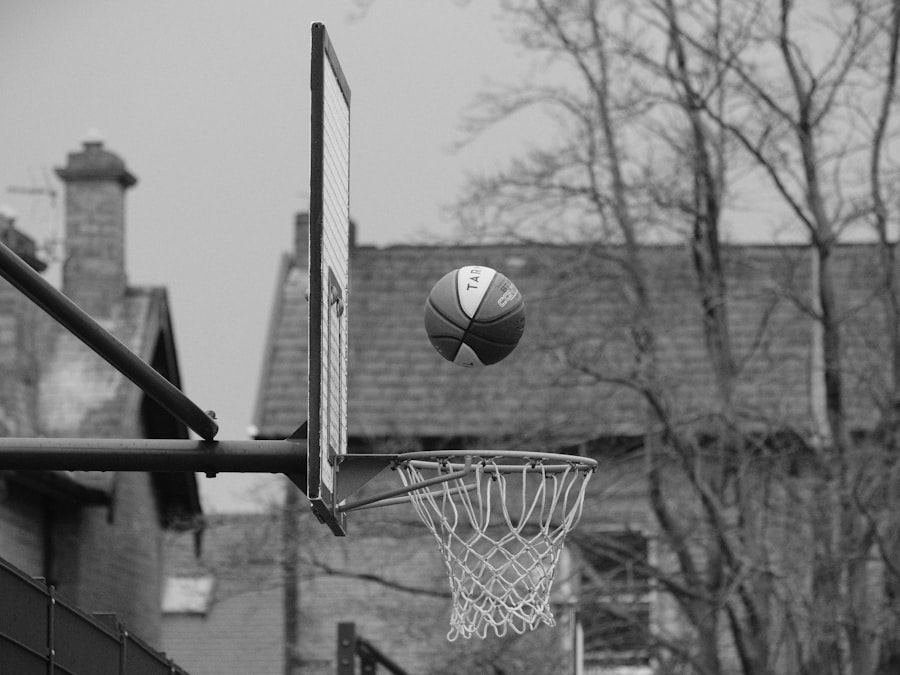Download links
How to install Dunking and Defense: The Keys to Basketball Success APK?
1. Tap the downloaded Dunking and Defense: The Keys to Basketball Success APK file.
2. Touch install.
3. Follow the steps on the screen.
Description
Dunking is often regarded as one of the most electrifying aspects of basketball, transcending mere scoring to become a symbol of athletic prowess and skill. The act of soaring through the air and slamming the ball through the hoop not only showcases a player’s physical abilities but also serves as a pivotal moment in a game that can shift momentum. A well-executed dunk can energize a crowd, instill confidence in teammates, and demoralize opponents.
This high-impact play is not just about points; it embodies the spirit of competition and the thrill of the sport. Moreover, dunking has historical significance in basketball culture. From the iconic dunks of legends like Michael Jordan and Kobe Bryant to contemporary stars like LeBron James and Zion Williamson, these moments have become etched in the annals of basketball history.
Dunk contests, particularly during the NBA All-Star Weekend, highlight the creativity and athleticism of players, further elevating the importance of dunking within the sport. The ability to dunk is often seen as a rite of passage for young players, representing a milestone in their development and a source of pride that can inspire future generations.
Key Takeaways
- Dunking in basketball is not just a flashy move, it is an important skill that can change the momentum of a game.
- Dunking can energize a team and excite fans, creating a positive impact on the overall performance and atmosphere of the game.
- Defensive strategies are crucial in determining the outcome of a game, as they can disrupt the opposing team’s offense and create scoring opportunities.
- Defense plays a key role in creating scoring opportunities by forcing turnovers and securing rebounds, leading to fast break opportunities and easy baskets.
- Dunking and defense work together to create a winning team, as they can both demoralize the opposing team and boost the morale of the home team.
- Training and drills focused on improving dunking and defensive skills are essential for players to elevate their game and contribute to the success of the team.
How Dunking Can Energize a Team and Excite Fans
The psychological impact of a dunk extends beyond the individual player; it reverberates throughout the entire team and fan base. When a player executes a spectacular dunk, it can serve as a catalyst for team morale. Teammates often rally around such moments, feeding off the energy generated by the play.
This surge in enthusiasm can lead to improved performance on both ends of the court, as players become more engaged and motivated to contribute. The collective energy can create a sense of unity, fostering an environment where players feel empowered to take risks and elevate their game. For fans, a dunk is often the highlight of a game, capable of igniting cheers and chants that resonate throughout the arena.
The visual spectacle of a player defying gravity captivates audiences, creating an electric atmosphere that enhances the overall experience of attending a game. This excitement can be particularly pronounced during critical moments, such as playoff games or rival matchups, where every point counts. The roar of the crowd following a thunderous dunk can serve as an emotional release, reinforcing the bond between players and fans while solidifying the game’s significance in the broader context of sports culture.
The Defensive Strategies That Can Make or Break a Game

While dunking garners much attention for its flair and excitement, defense is equally crucial in determining the outcome of a basketball game. Effective defensive strategies can stifle an opponent’s scoring opportunities and create turnovers that lead to fast-break situations. Teams often employ various defensive schemes, such as man-to-man or zone defenses, each with its own strengths and weaknesses.
A well-executed defensive strategy can disrupt an opponent’s rhythm, forcing them into difficult shots or leading to mistakes that can be capitalized on. One common defensive tactic is the use of double-teaming, where two defenders converge on a single offensive player to apply pressure and limit their options. This strategy can be particularly effective against star players who are known for their scoring ability.
By forcing them to pass the ball or take contested shots, teams can neutralize their impact on the game. Additionally, defensive rotations are essential for maintaining coverage and preventing open looks from three-point range or easy layups. A cohesive defensive unit that communicates effectively can create a formidable barrier against even the most skilled offenses.
The Role of Defense in Creating Scoring Opportunities
| Defense Metric | Description |
|---|---|
| Interceptions | The number of times a defender intercepts the ball from the opponent, creating a potential scoring opportunity for their team. |
| Tackles | The successful defensive actions taken by a player to dispossess the opponent and regain possession of the ball, leading to a potential scoring chance. |
| Clearances | The defensive action of kicking or heading the ball away from the goal area, preventing the opponent from creating scoring opportunities. |
| Blocks | The number of times a defender blocks a shot or a pass from the opponent, denying them a potential scoring chance. |
Defense is not merely about preventing points; it also plays a critical role in generating scoring opportunities for a team. A strong defensive performance can lead to fast breaks, where players transition quickly from defense to offense, catching opponents off guard.
This quick transition can result in high-percentage shots, such as layups or dunks, which are more likely to convert into points. Moreover, defensive rebounds are vital in creating scoring opportunities. Securing the ball after an opponent’s missed shot allows a team to regain possession and initiate their offensive plays.
Teams that excel in rebounding often find themselves with more opportunities to score, as they can control the tempo of the game and dictate their offensive strategy. Additionally, effective defense can lead to fouls committed by opponents, resulting in free throw opportunities that can further bolster a team’s scoring efforts.
How Dunking and Defense Work Together to Create a Winning Team
The interplay between dunking and defense is essential for building a successful basketball team.
A team that excels at both ends of the court creates a balanced approach that is difficult for opponents to counteract.
For example, teams with strong defensive capabilities can create turnovers that lead to fast-break opportunities for highlight-reel dunks, effectively combining both elements into a cohesive strategy. Furthermore, players who are adept at dunking often possess athleticism that translates well into defensive capabilities. Their ability to jump high not only allows them to finish at the rim but also enables them to contest shots effectively and secure rebounds.
This dual-threat capability makes them invaluable assets on both ends of the court. Coaches who emphasize the importance of both dunking and defense foster an environment where players understand that success is not solely measured by points scored but also by their contributions on defense.
Training and Drills for Improving Dunking and Defensive Skills

To enhance dunking ability, players must focus on developing their vertical leap through targeted training regimens. Plyometric exercises such as box jumps, depth jumps, and jump squats are effective for building explosive power in the legs. Additionally, strength training focusing on lower body muscles—such as squats and lunges—can contribute significantly to vertical leap improvement.
Incorporating agility drills that enhance foot speed and coordination will also aid players in gaining the necessary momentum for successful dunks. On the defensive side, training should emphasize footwork, positioning, and anticipation skills. Drills that simulate game situations—such as one-on-one defensive scenarios—can help players practice staying low in their stance while maintaining balance and agility.
Additionally, incorporating drills that focus on closing out on shooters will improve defenders’ ability to contest shots effectively without fouling. Practicing communication during defensive drills fosters teamwork and ensures that players are aware of their responsibilities within various defensive schemes. In conclusion, both dunking and defense are integral components of basketball that contribute significantly to a team’s success.
By understanding their importance and implementing effective training strategies, players can develop their skills in both areas, ultimately leading to improved performance on the court.
If you’re a fan of basketball, you may also enjoy reading about the popular mobile game Hill Climb Racing 2. This game requires skill and strategy, much like basketball, as players navigate challenging terrain and obstacles to reach the finish line. Check out this article to learn more about the exciting world of mobile gaming.
FAQs
What is basketball?
Basketball is a team sport in which two teams, typically consisting of five players each, compete to score points by shooting a ball through the opposing team’s hoop.
What are the basic rules of basketball?
The basic rules of basketball include dribbling the ball while moving, shooting the ball into the opposing team’s hoop, and playing defense to prevent the opposing team from scoring.
What equipment is used in basketball?
The main equipment used in basketball includes a ball, hoop, and court. Players also wear specialized basketball shoes and may use protective gear such as knee pads and ankle braces.
How is basketball played?
Basketball is played on a rectangular court with a hoop at each end. Players move the ball by dribbling or passing to teammates, and score points by shooting the ball through the opposing team’s hoop.
What are the health benefits of playing basketball?
Playing basketball can improve cardiovascular health, build endurance, and enhance coordination and balance. It also provides a full-body workout and can help with weight management.
What are the different positions in basketball?
Common positions in basketball include point guard, shooting guard, small forward, power forward, and center. Each position has specific roles and responsibilities on the court.
What are some famous basketball leagues and tournaments?
Famous basketball leagues and tournaments include the National Basketball Association (NBA) in the United States, EuroLeague in Europe, and the FIBA Basketball World Cup. College basketball in the US is also popular, with the NCAA tournament being a major event.





